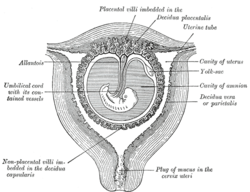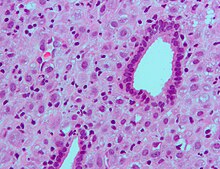| Decidual reaction | |
|---|---|
 Sectional plan of the gravid uterus in the third and fourth month. | |
| Anatomical terminology |

Decidualization is a process that results in significant changes to cells of the endometrium in preparation for, and during, pregnancy. This includes morphological and functional changes (the decidual reaction) to endometrial stromal cells (ESCs), the presence of decidual white blood cells (leukocytes), and vascular changes to maternal arteries. The sum of these changes results in the endometrium changing into a structure called the decidua. In humans, the decidua is shed during childbirth.[1]
Decidualization plays an important role in promoting placenta formation between a mother and her fetus by mediating the invasiveness of trophoblast cells. It also triggers the production of cellular and molecular factors that result in structural changes, or remodeling, of maternal spiral arteries. Decidualization is required in some mammalian species where embryo implantation and trophoblast cell invasion of the endometrium occurs, also known as hemochorial placentation. This allows maternal blood to come into direct contact with the fetal chorion, a membrane between the fetal and maternal tissues, and allows for nutrient and gas exchange. However, decidualization-like reactions have also been observed in some species that don't display hemochorial placentation.[2]
In humans, decidualization occurs after ovulation during the menstrual cycle. After implantation of the embryo, the decidua further develops to mediate the process of placentation. In the event no embryo is implanted, the decidualized endometrial lining is shed or, as is the case with species that follow the estrous cycle, absorbed.[1] In menstruating species, decidualization is spontaneous and occurs as a result of maternal hormones. In non-menstruating species, decidualization is non-spontaneous, meaning it only happens after there are external signals from an implanted embryo.[3]
- ^ a b Pansky, Ben (1982-08-01). Review of Medical Embryology. McGraw-Hill. ISBN 9780071053037.
- ^ Kurjak, Asim; Chervenak, Frank A. (2006-09-25). Textbook of Perinatal Medicine, Second Edition. CRC Press. ISBN 9781439814697.
- ^ Emera, Deena; Romero, Roberto; Wagner, Günter (2011-11-07). "The evolution of menstruation: A new model for genetic assimilation". BioEssays. 34 (1): 26–35. doi:10.1002/bies.201100099. ISSN 0265-9247. PMC 3528014. PMID 22057551.